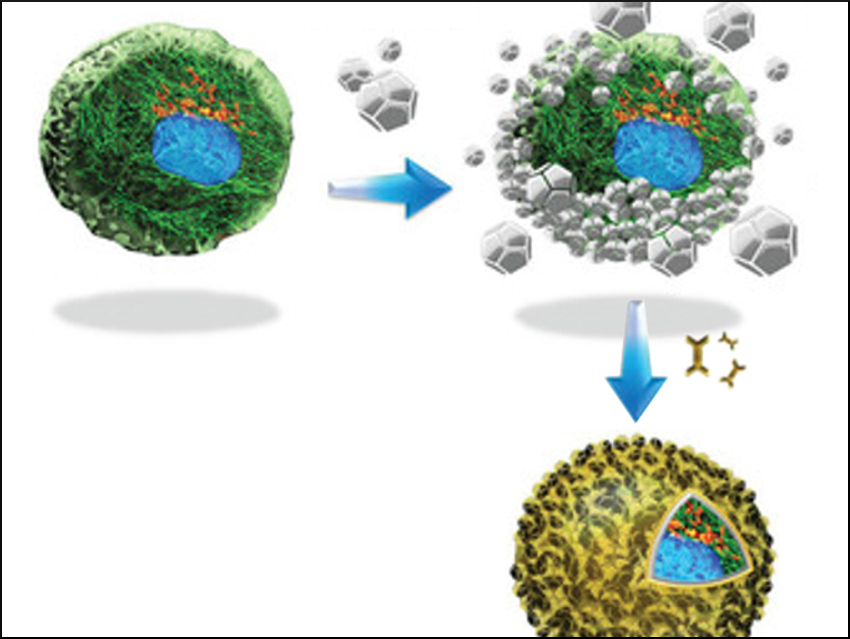Improved Resistance for Mammalian Cells
Mammalian cells are fragile constructions. They harbor a finely adjusted and complicated machinery made of soft matter, but the only boundary to the outside is a thin, almost liquid membrane bilayer pecked with pores. Outside their familiar extracellular matrix and without contact with neighboring cells, adherent cells are vulnerable to all sorts of physical or chemical stresses.
To make these cells more resilient, Wei Zhu, South China University of Technology, Guangzhou, and The University of New Mexico, Albuquerque, USA, Jonas G. Croissant, C. Jeffrey Brinker, The University of New Mexico, and colleagues have developed a nanoparticle shell which can be wrapped around single cells like chainmail. It is composed of inorganic nanoparticles glued together and tethered to the cell membrane through polyphenol complexation. The coat shields the cells against stress factors such as hydrogen peroxide, extreme pH, UV irradiation, and nanoparticle toxins while keeping them in a non-proliferating state.
Encapsulation of Cells
Adherent mammalian cells have special requirements when growing them in cultures. They prefer to be encapsulated in small bundles in a matrix made of soft matter, such as alginate or dextran. This helps them to proliferate. However, encapsulation can also be used as a means for physical and chemical protection.
The researchers developed an encapsulation system for single cells that rather resembles a solid armor. This exoskeleton formed of nanoparticles and held together by tannic acid as a biocompatible glue blocks larger particles and many other stress factors, but is permeable to small molecules and nutrients, thus keeping the cell in a silent, spore-like state.
Like a Breadcrumb Coating
When forming the exoskeleton, the team took advantage of the fact that synthetic nanoparticles naturally interact with mammalian cell surfaces. This is because proteins and other cellular membrane components form multiple noncovalent bonds with the hydroxides and metal ions present in the nanoparticulate structures: metal–organic frameworks, zeolites, iron oxide, or silica nanoparticles. The usual consequence of these interactions, however, is rapid internalization.
To suppress internalization, the scientists added tannic acid to the system. Tannic acid is a polyphenol containing a lot of hydroxy groups, which are able to complex metal ions as well as interact with the membrane surface. The result was a cocoon of interwoven nanoparticles wrapped around the cell. Cross-linking proceeded instantaneously within seconds, the team found when they mixed human HeLa cells with a variety of inorganic nano-building blocks including zeolites, metal-organic frameworks, or silica, and tannic acid. This procedure resembles a sort of one-pot breadcrumb coating, only that frying in a pan is not a necessary step in this case.
Resilience and Resistance
The coated cells—called SupraCells—were vital and took the procedure well. However, they neither adhered, spread, or proliferated—these functions seemed to be switched off in their shell. On the other hand, the team observed better resistances to external stresses such as osmotic pressure, oxygen radicals, pH extremes, UV light, and particles larger than 5 nm.
The researchers attribute the resistance to a sieving and shielding effect. The armor (or crust) of inorganic nanoparticles simply blocks larger particles, and the metal ions in the zeolites or metal-organic frameworks buffer pH changes or catch salt ions. To return the cells to their adherent state, the scientists added ethylenediaminetetraacetic acid (EDTA) as a metal chelating agent, which disassembled the armor.
Quick Procedure, High Versatility
This cell encapsulation strategy combines cell surface coating with incorporating inorganic building blocks. The nanoparticles adhere to the cells and to themselves through a coordination- and hydrogen-bond-based hybrid network. The gluing is so effective that a stable exoskeleton is formed. The advantages of this strategy are the quick and easy formation of the shell and the many possibilities the inorganic building blocks provide.
As many different kinds of nanoparticles can be used, even at the same time, possible applications span a wide range of research fields. The team imagines, e.g., cell transport, tissue targeting, cell-based sensing under extreme conditions, or 3D cell printing. Cell encapsulation has got a new twist.
- SupraCells: Living Mammalian Cells Protected within Functional Modular Nanoparticle-Based Exoskeletons,
Wei Zhu, Jimin Guo, Shahrouz Amini, Yi Ju, Jacob Ongudi Agola, Andreas Zimpel, Jin Shang, Achraf Noureddine, Frank Caruso, Stefan Wuttke, Jonas G. Croissant, C. Jeffrey Brinker,
Adv. Mater. 2019.
https://doi.org/10.1002/adma.201900545



